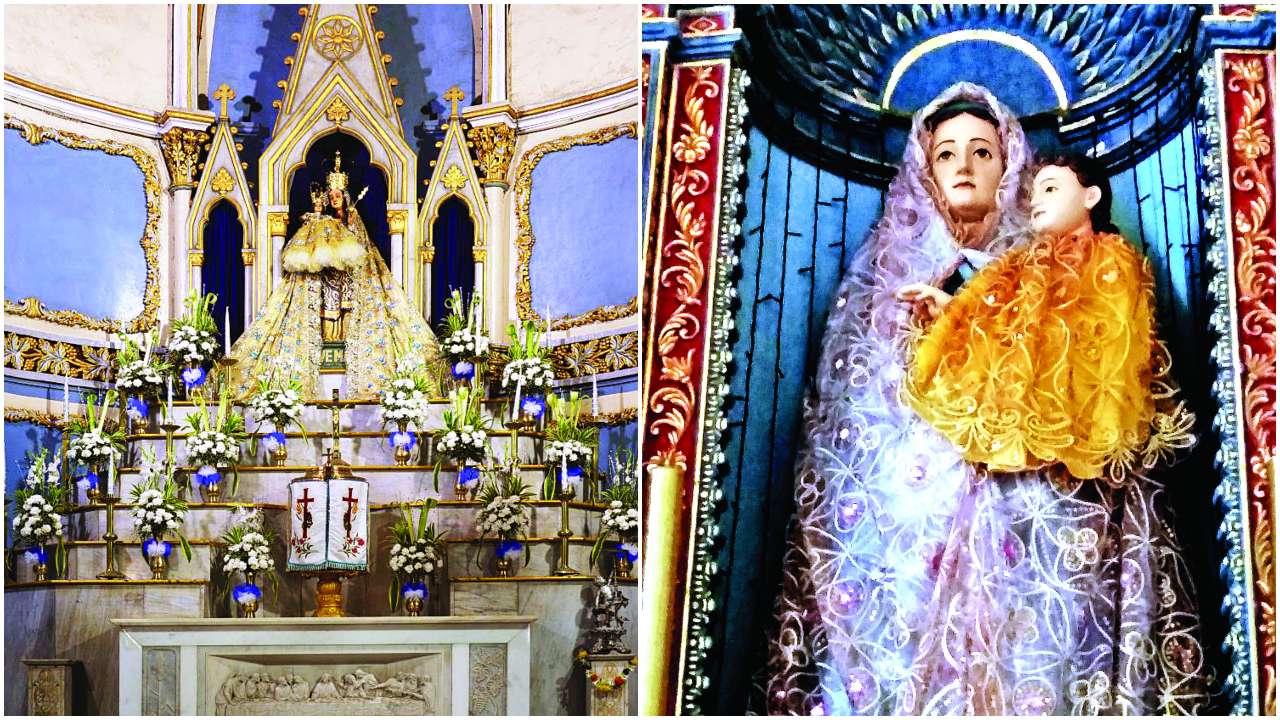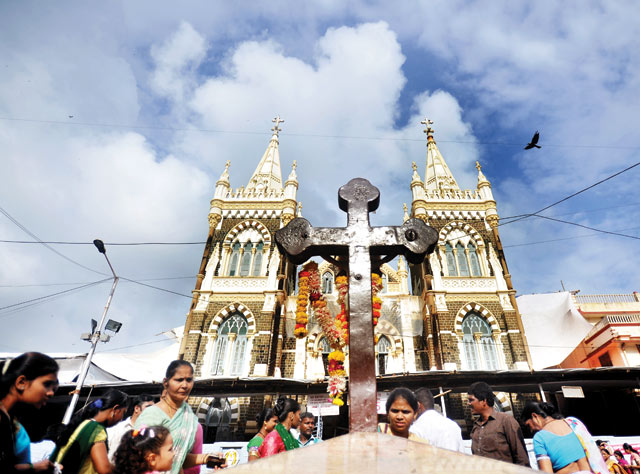
"No, it was the kolis who found the Mount Mary statue in their fishing net...," blurts Bazaar Road's bandwallah Joe Vessaoker, a 68-year-old thorough-bred Bandra boy, who hails from a family of musicians and vocalists that fuelled Mumbai's glorious jazz era of the 60s and 70s.
Vessaoker, like many others, refuses to believe what Church historians and even information sharing sites like Wikipedia acknowledge: That the Our Lady of Navigators (OLN) statue, nestling in a nook to the right of the altar at Bandra's St Andrews Church was the one found at sea. Not Our Lady of the Mount (OLM) at the Bandra Basilica.
Roman Catholics consider September 8 to be the Nativity (birthday) of Mother Mary, and the annual Bandra fair at the 1904 Gothic-style Basilica of Our Lady of the Mount is one celebration that see people of all faiths participating in. For many, venerating the idol comes with benefits – indulging in the stalls selling kadio bodiyo (orange ginger and white sugar sticks), aam papad (mango fruit leather), black gram, gelatin-like halva, tins of soapy bubble mixture, and offering your wants through 3D wax prayers – a house, an injured part of your anatomy, child, and even money (replica of Rs 2000 notes post demonetisation). Not to forget those sprightly cane sticks. One whack ensures a nice stinging red mark and elicits a promise to not repeat the mischief you were reprimanded for.
But there are many disgruntled Bandra residents, who've strived, in vain, to ban the fair for the noise, traffic jams, and eve teasers and bottom pinchers it brings, to a point they altogether avoid this patch of Bandra during the two weeks of festivity. Both groups, however, agree with Vessaoker.
In his book, Heritage of Mount Mary Bandra, Monsignor (Msgr) Francis Correa draws up a list of legends on the statue of Mount Mary – she originally held an orb in one hand and a spectre in the other, and wore a crown of seven stars to establish her governance over heaven and earth. The book cites Braz Fernandes' Religious and Secular History that claims a band of Muscat Arabs, apart from tearing down paintings from the gilt frames, cut off OLM's right foream for the spectre, which they mistook for real gold. The desecrated statue was moved to the lumber room, and the OLN statue became its perfect body double to avoid a barren altar at the Mount. In 1761, the OLM statue was reinstated at the altar after it was fitted with a baby Jesus statue to hide it's broken forearm, and the OLN was returned to St Andrew's Church.
Another theory in Fernandes' book says the Marathas, in 1739, during their invasion of Salsette island, destroyed the chapel and flung the OLM statue into the sea. The kolis found it one of their fishing nets, concealed it for six months in a rock fissure, before stealthily transporting it to Mahim's St Michael Church, then under the British, to safeguard. In 1761 it was returned to the Mount in a car. "But, in this copy, that Larry Pereira (another respected historian now deceased) gave me, he's marked a big 'NO!' after the part that states the Marathas ruthlessly snatched the statue from the altar and threw it into the sea in 1738, and another 'NO!' for it being transported from St Micheal's to the Mount in a car in 1761. I agree with him, because back then only bullock carts were present, and Mahim and Bandra was not joined by Causeway," says Msgr Correa.
Conservation architect and Bandra-bred David Cardoz offers more a couple of more theories to encourage confusion. "It's possible that the Arabs took the whole statue with them, then chopped only what they assumed to be of value – the arm – and then threw the statue back in the sea, and the sea brought it back again to the kolis." He also hits a dead end trying to link the OLN statue as the one the fisherfolk found in their nets, which they handed over to St Andrews Church. "It's unlikely that St Andrews Church designed a niche without a statue and then suddenly found one that fit perfectly in that niche!" While historians continue to debate, the masses happily throng to the shrine. Faith, after all, is indestructible.
Having witnessed the frenzy of long queues, copious offerings of garlands, candles, expensive handwoven and embroidered veils to OLM, fair and stall management, marathon mass services especially on the two Sundays, blessing and counseling countless devotees at this time is the 95-year-old young-at-heart ex-rector of the Basilica Msgr Nereus Rodrigues. "From walking on their knees to fasting… the things people do, the numbers they come in... baffles me even now!" says the nonagenarian, known as the man behind forming St Andrews College in 1983.
OLM's 'mother-and-child' restored setup was done to match the flurry of votives and written petitions that the OLN statue, when installed in her place, received from couples unable to conceive. "As children of seven-eight years old, we were 'sold' to Mary or cast under her protection, because back then, poor medical facilities meant one could easily contract any disease and die. As the case of Jamsetjee Jejeebhoy's daughters," says Cardoz.
Parsi businessman Jejeebhoy and his wife were heartbroken when none of their daughters survived beyond age seven, and over one dinner voiced their grief to close friends – a Catholic businessman Sir Roger de Faria and his family. Faria's daughter told Jejeebhoy to make a vow to Mount Mary if she blessed them with a girl who survives the seven-year hitch. When a daughter Pirojbai was born (and lived till 72), Lady Jejeebhoy, in gratitude, built the Mahim Causeway in 1845, after 20 boats of inferior make capsized and their inhabitants sent to a watery grave. The Jejeebhoys even offered a gold crown among a paraphernalia of gold and pearl jewellery to Mount Mary, and built a flight of stairs at the foot of the hill – now highly colourful and under the BMC's purview.
Like Jejeebhoy, Mary's answered her prayers, says 50-year-old Kiran Singh, originally from UP, who has, for 30 years, had a stall at the fair, after her husband became gravely ill. Odd jobs and generosity from relatives and NGOs saw her pull through his medical expenses and educate her three kids. Once, when her husband's spinal cord surgery required her to arrange eight bottles of blood, she found herself seeking solace in Mary at the Irla's Church of Our Lady of Health of Velankanni situated near the hospital he was admitted to. "Maine Maa ko kaha 'mere paas ek boondh ke bhi vyavastha nahi hai. Aap hi kuch karo' (I told Mother Mary I don't have the resources to arrange for even a single drop of blood)" As what she considers a miracle, the doctor didn't find the need to use a single drop of blood during the eight-hour operation. Singh now regularly visits Mount Mary and chants the same mantras as for her Hindu devis.
Mukesh Shahu, 48, a sweet concoction supplier from Nallaspora, who's set up two stalls at the fair past 25 years on the Basilica's stairs, believes a darshan to Mary on her birthday results in good business for his Calicut ka halwa (from Kozhikode) and toffee, malai barfi, khaja, from Mumbai, and tide the rent – Rs 15, 000 (*price varies as per sq ft), Rs 1500 for electricity and some extra for the mandap. "Woh hamari devi hi hai (She's our female deity)."
Monika Sharma used to pray hard at the shrine before and after every exam as while studying architecture at a Bandra college. From 18 years, despite moving residence from Bandra to Thane and now based at Andheri, she unfailingly visits the shrine once in three months. "I've got my parents and my friends visiting Mumbai, here. I've lit candles for lasting friendships. I even believed in the myth that baby Jesus moves from Mary's one arm to the other," chuckles Sharma, an independent architect, designer and teaching professional. "It's the vibe that places like this, architecturally designed to pull crowds, have. It provides hope. And for me, Mother Mary is a kuladevata (family deity)."

(Pic: Aadesh Chaudari/DNA)
But today's celebration lacks the spiritual essence it had 40 years ago, feels Vessaoker. To ensure devouts made it to the 5am novena mass, his father, a butcher and band master, would wake up the area at 4am with a bang – a shell-like contraption he'd fill with gunpowder and fling it towards the shore (now Reclamation) that then hugged their home off Chapel Road, Bandra. To soothen the cruel astir, he and his band accompanied churchgoers, playing hymns. "My parents insisted I attend the services, but I anyway looked forward to it. It was peaceful. But now it's just chaos," bemoans Vessaoker, though grateful for a tradition that's stayed on – taking the statue of Mary on a palkhi in procession through Bandra roads during the novena days, where he trudges along with his saxophone, playing English, Konkani and Marathi hymns like Bells of the Angelus, Oh Come to the Throne of Grace, Maiden Mother, and Maria Mai Moji (My Mother Mary). Though he misses munching on servings of boiled chana and coconut slices, instead of the snack boxes given to pick up and walk off."
Msgr Rodrigues fondly recollects how 40 years ago the stalls sold exquisite imported toys from Japan like battery-operated cars and boats running on steam. One year, his brother, while ogling at these toys, got left behind in the fair. "After much searching, the fellow himself spotted our dad, ran up to him and hugged his legs," he chuckles.
However, 71-year-old St Peter Colony resident, Jennifer Dsouza and her sister, continue their mother's tradition of inviting their whole D'Souza-Nunes-Foncesa brigade – one of Bandra's old East Indian families – for a home-made lunch on the Sunday after September 8. This big, fat jamboree collects at Dsouza's three-storey bungalow on Rebello road to gorge on sumptuous East Indian dishes of sorportel, duck moliee, fugiyas, vindaloo, roast pigling. D'Souza, who after having developed aching feet, rarely visits the shrine. "For me, the statue just visually represents Mary. I don't have to pray to her at the Mount for my prayers to be answered."
But Mangalore-based sceptic and godman debunker Narendra Nayak considers idol worship innate to homo sapiens. "We say god is formless, yet like to visualise this god as an icon, statue or image." He attributes blind faith towards idols to either Placebo effect, spontaneous remissions or a self-limiting disease. "Like a common cold that heals in seven days. If you think an idol can cure you of a disease, that's pretty stupid." Nayak feels, if the Catholic church does believe in such 'miracles', then devotees need not visit the hospitals the clergy is known to erect. "They can be sent on a pilgrimage instead to get healed."
The Church examines these 'miracles' with a fine toothed comb, clarifies Msgr Nereus. So it's a miracle if a miracle passes the test. "Specialists conduct a series of tests to determine if the 'miracle' is really the doing of Our Lady. Though many say they've received special graces from Mary, I don't easily believe in these 'miracles'," he says pointing to the Our Lady of Lourdes church in France, where the Marian apparitions took place. Since 1858, only 69 cases are declared as miracles or cures, from the countless it has received. "That people flock to Mount Mary in large numbers even today is a miracle in itself…", Msgr Correa sums it nicely.